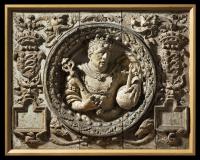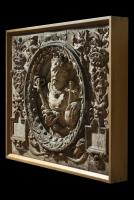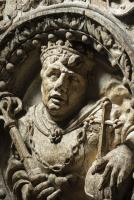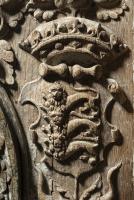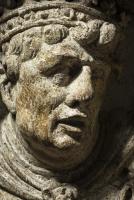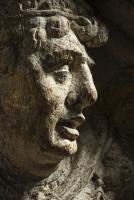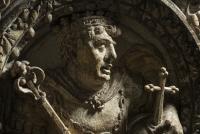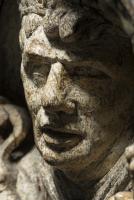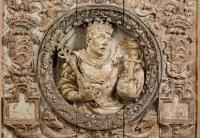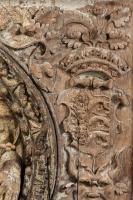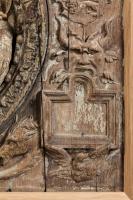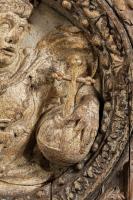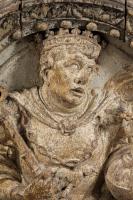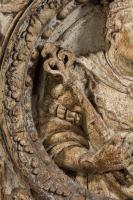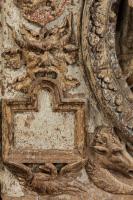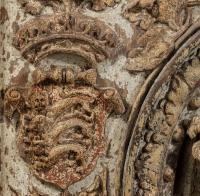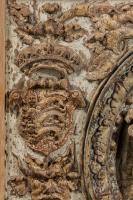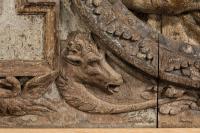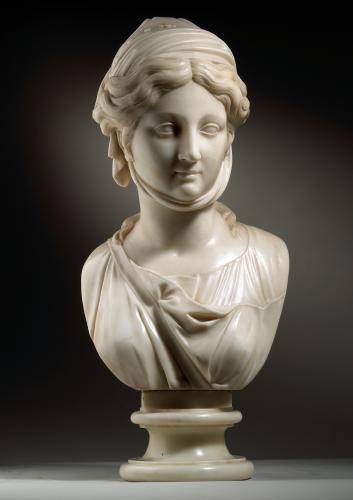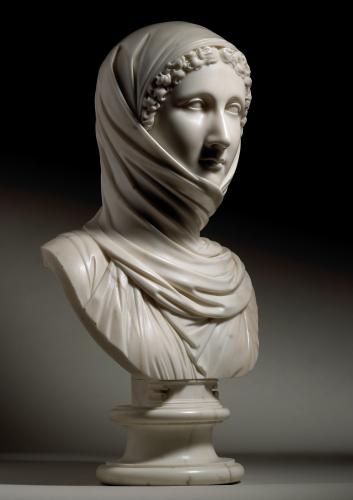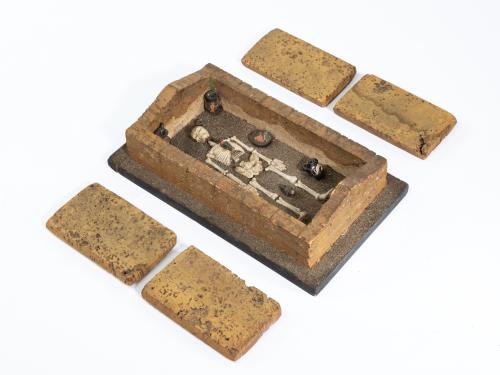
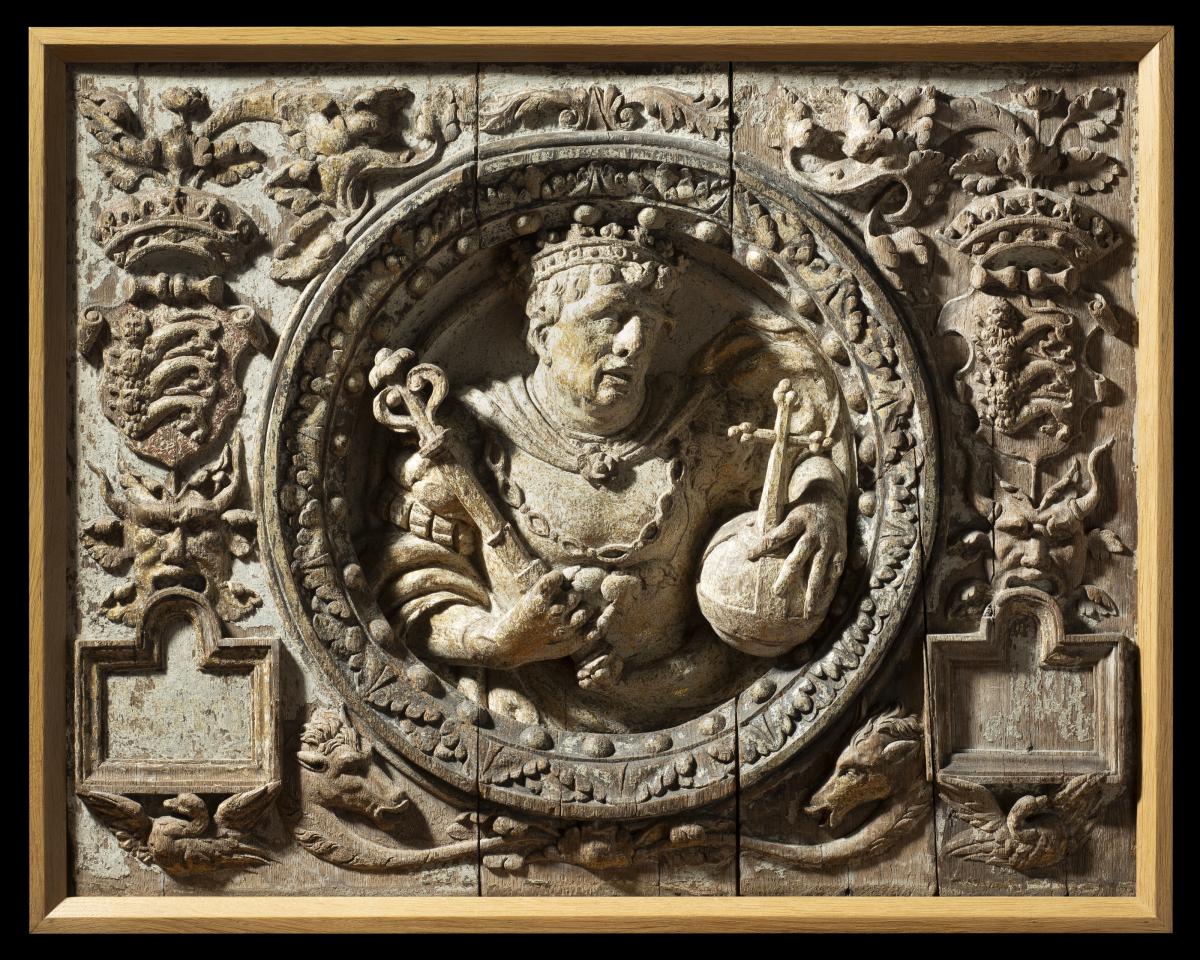
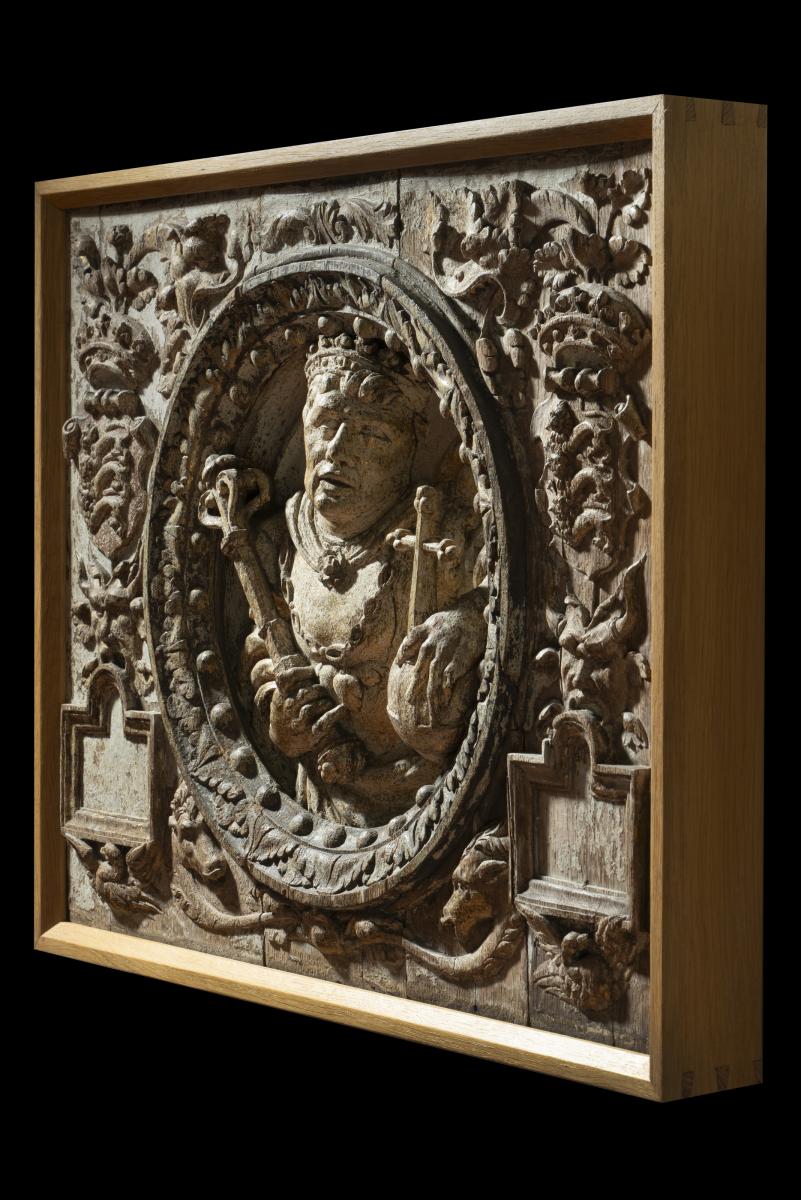
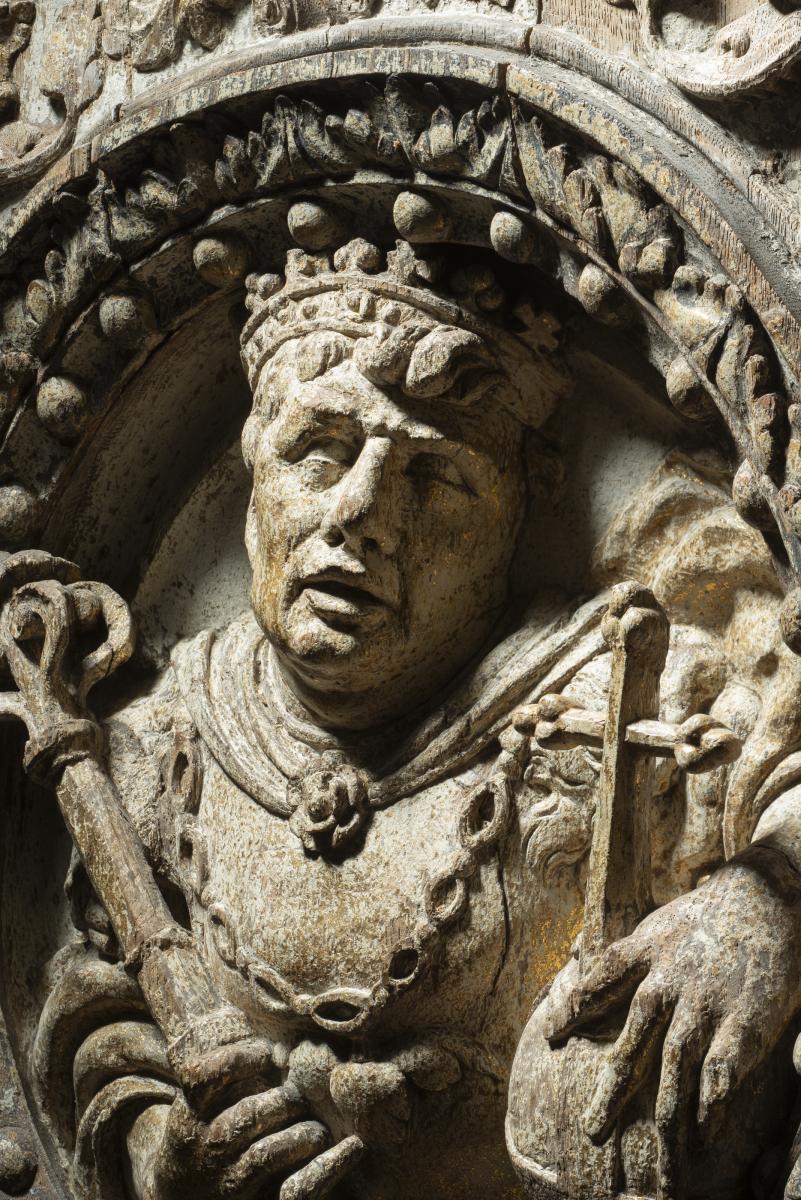
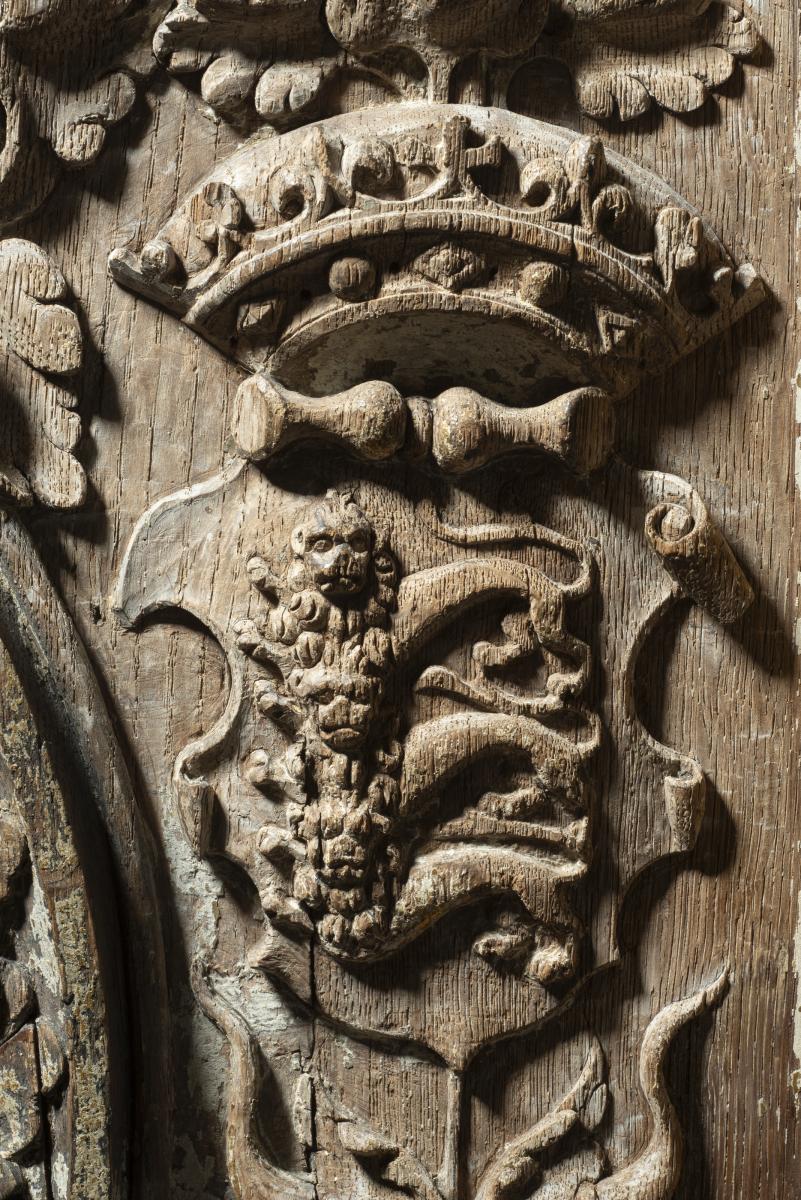
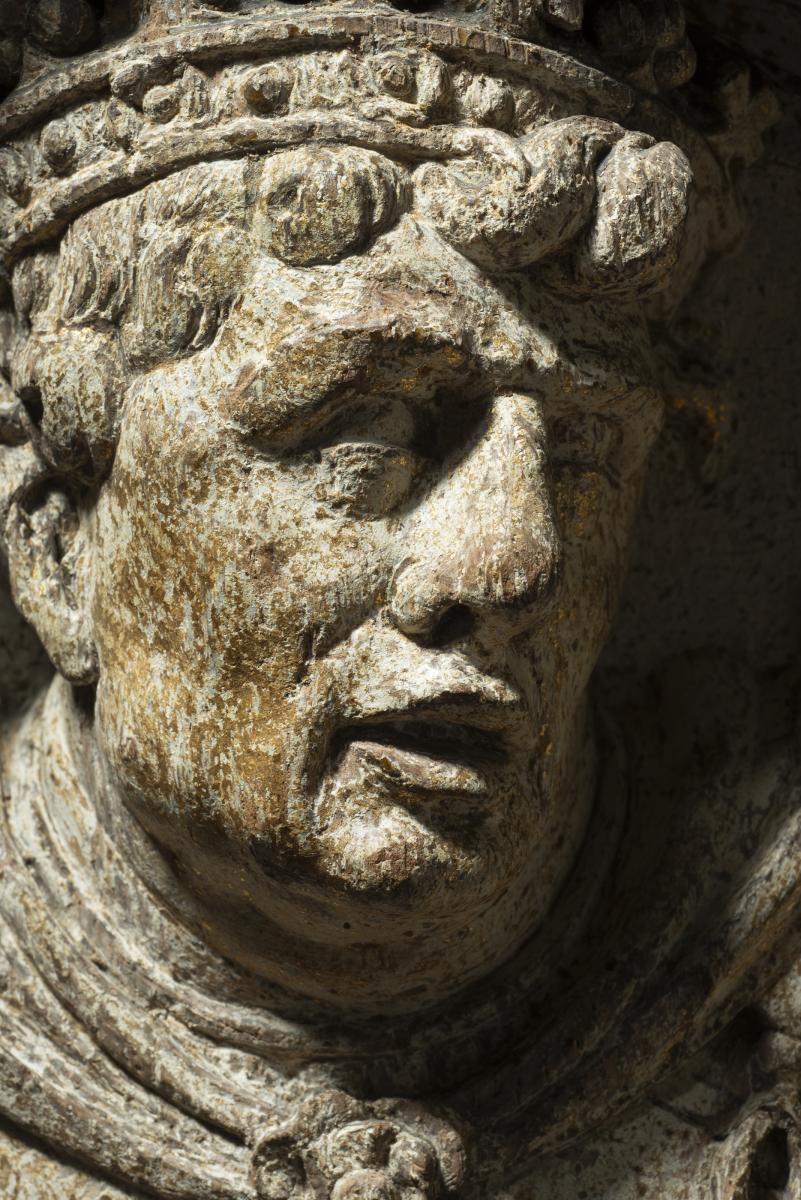
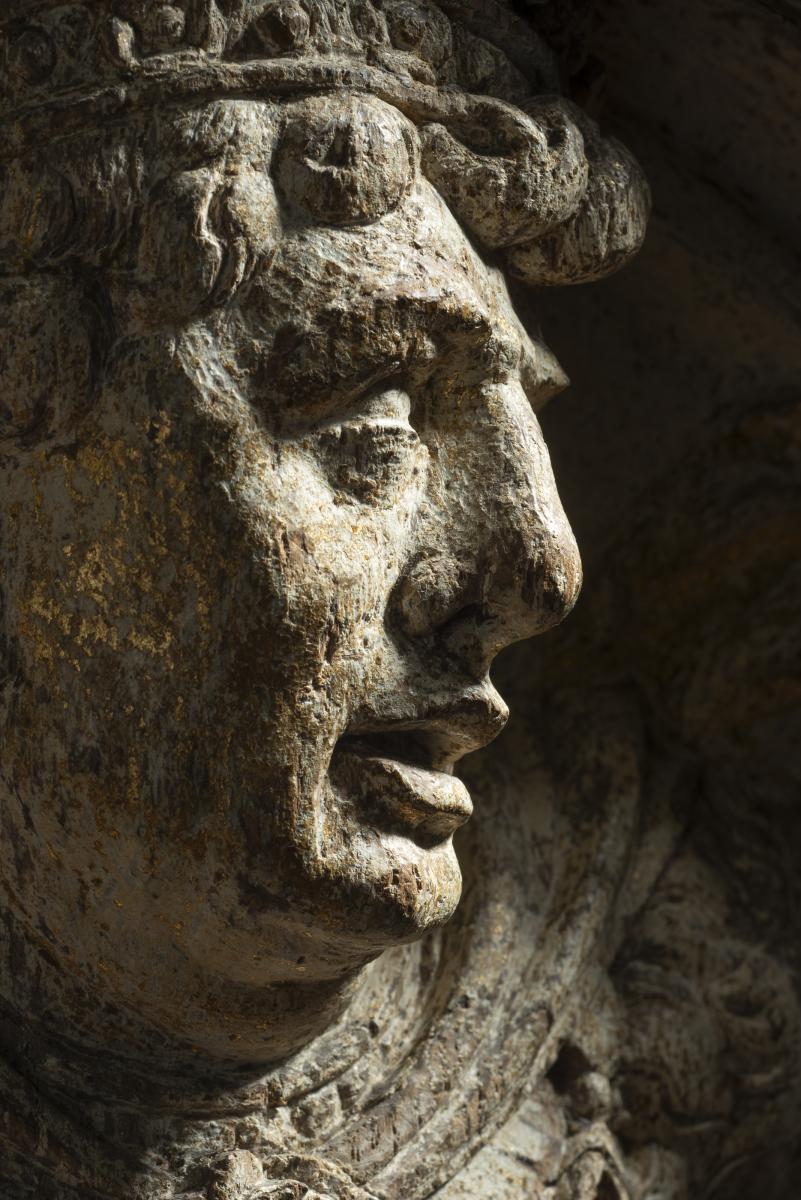
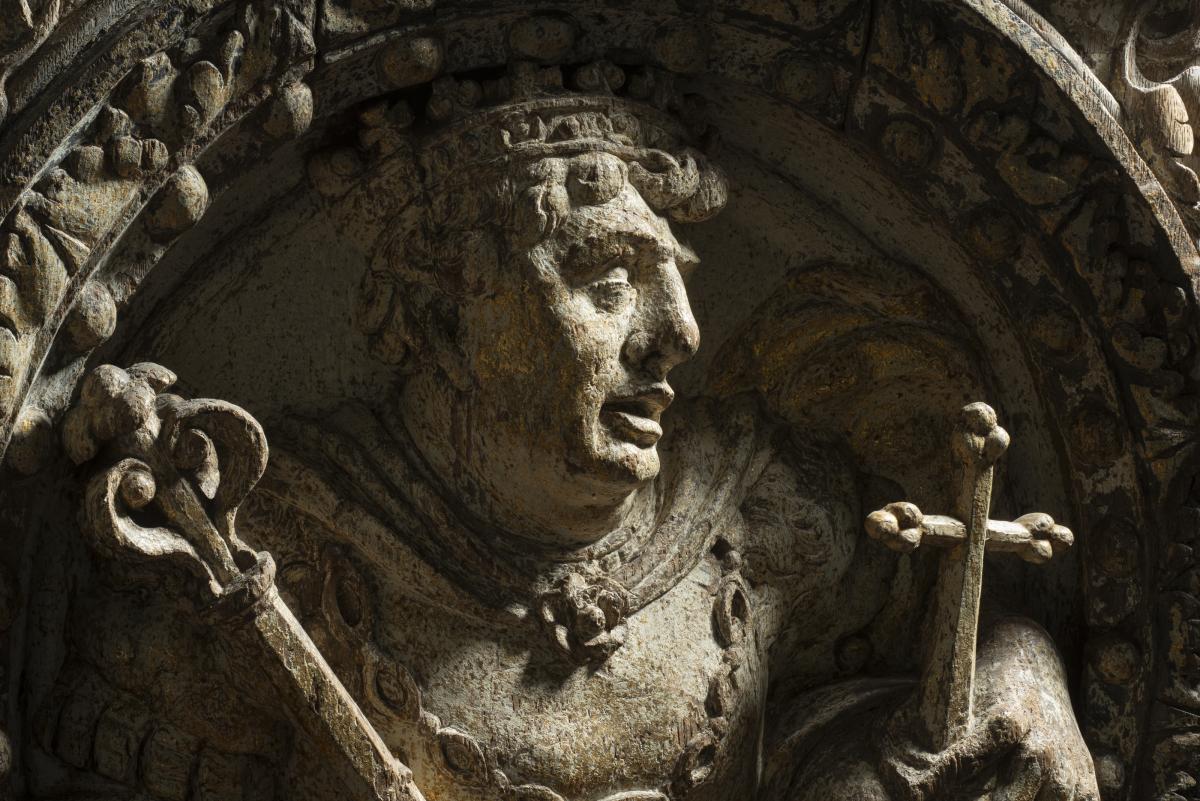
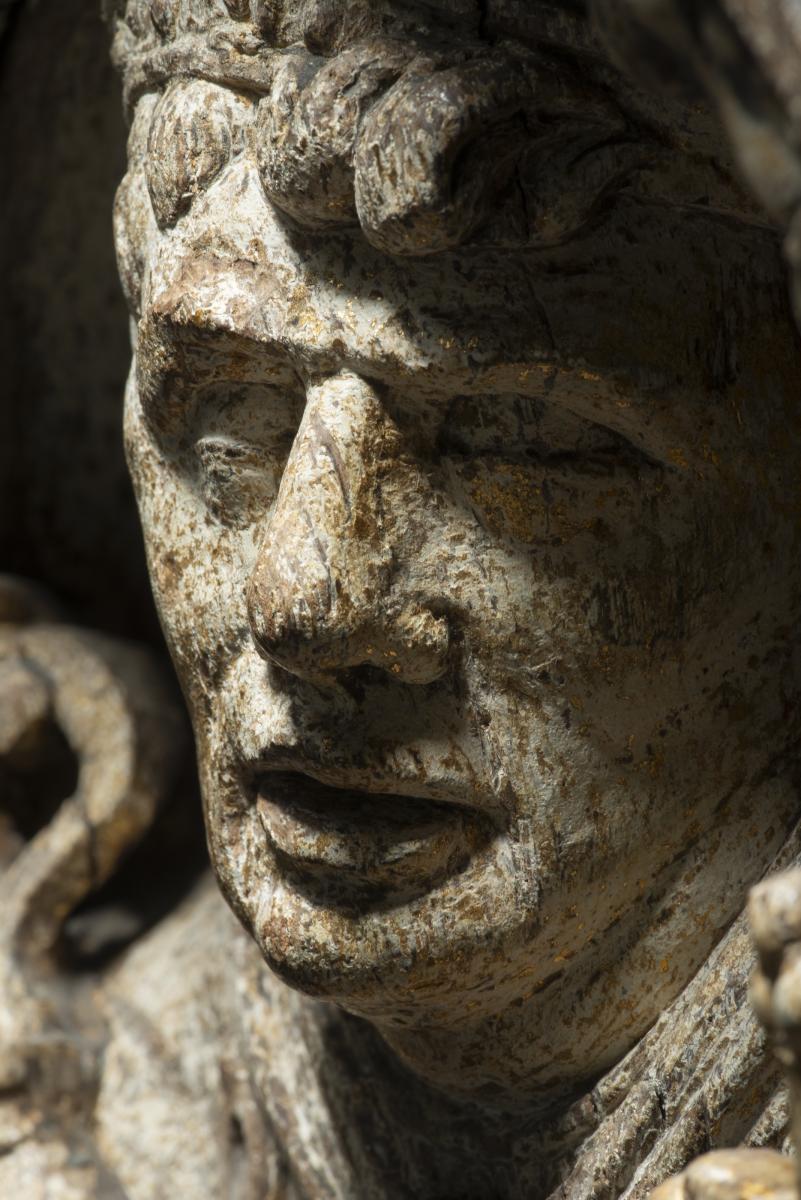
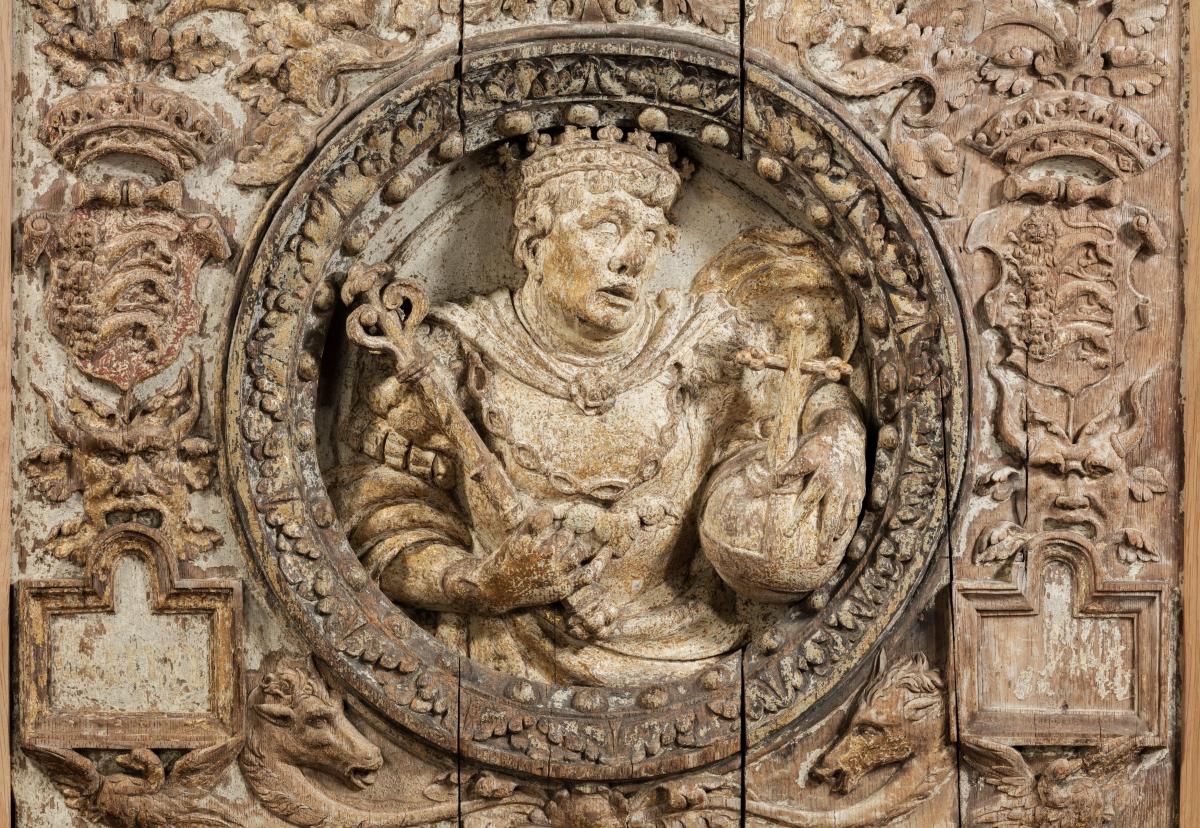
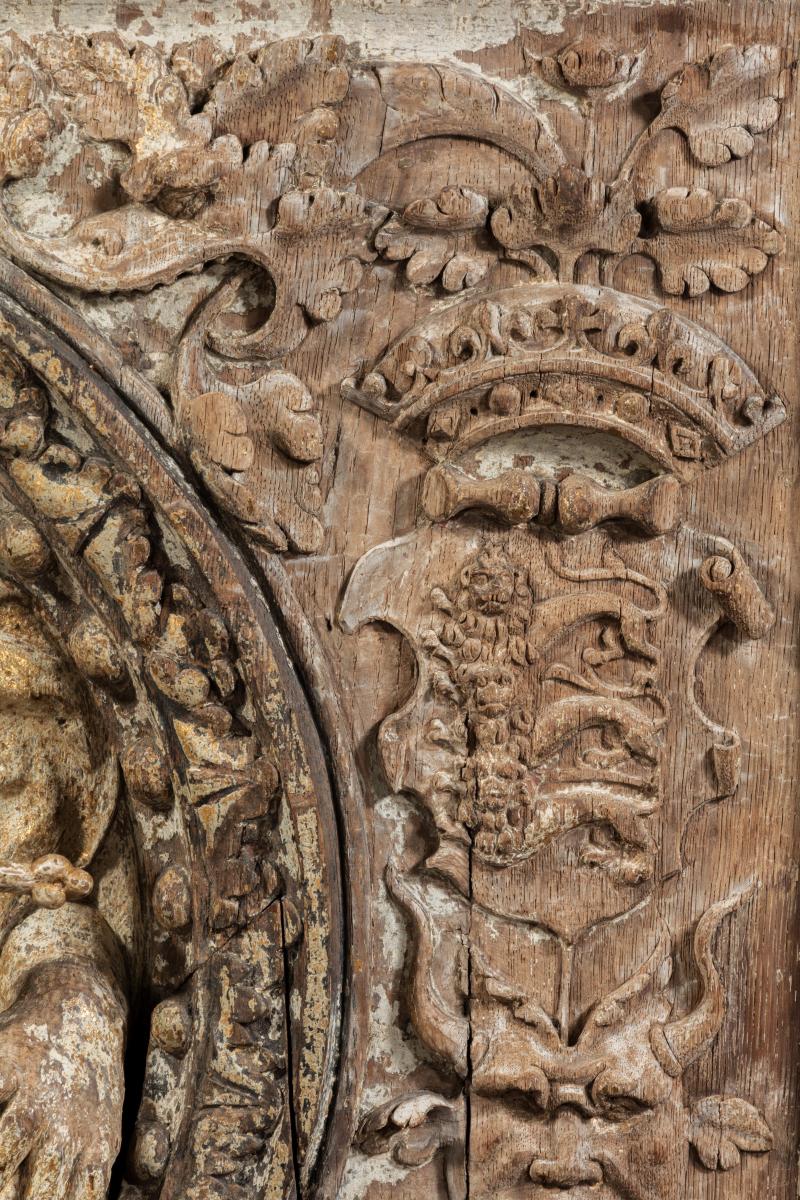
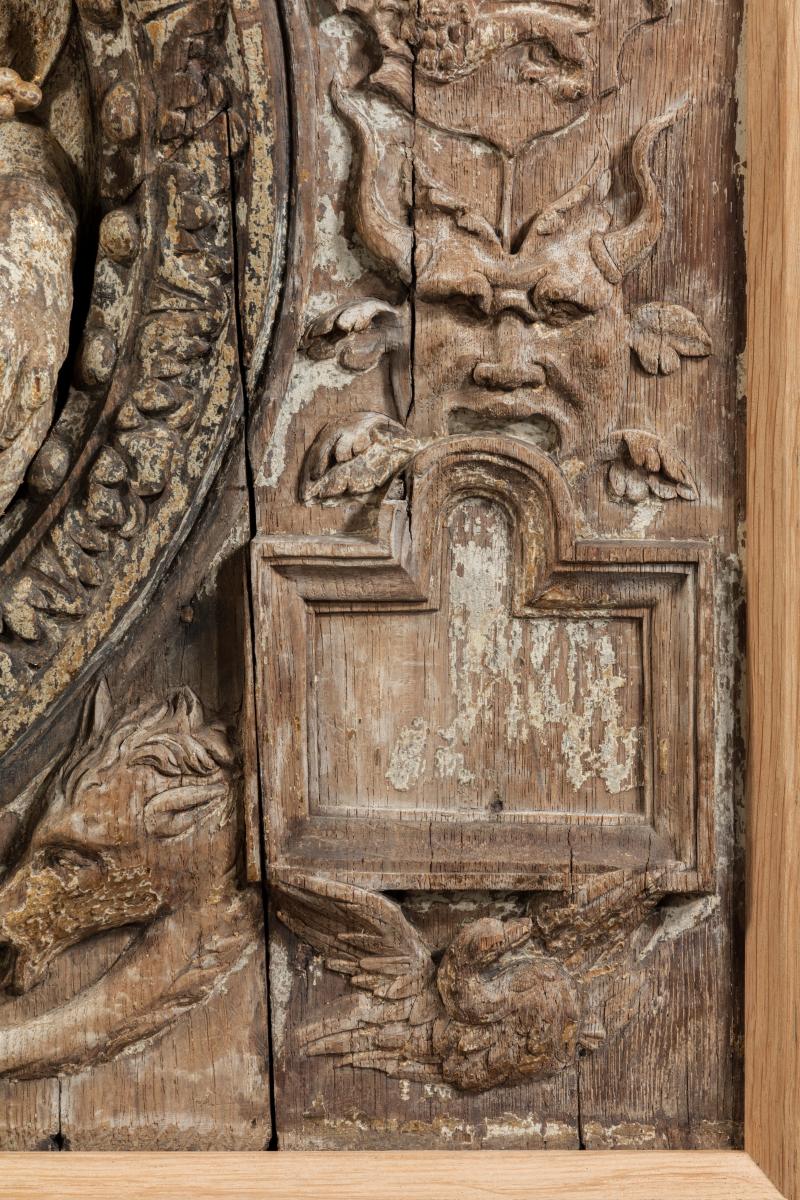
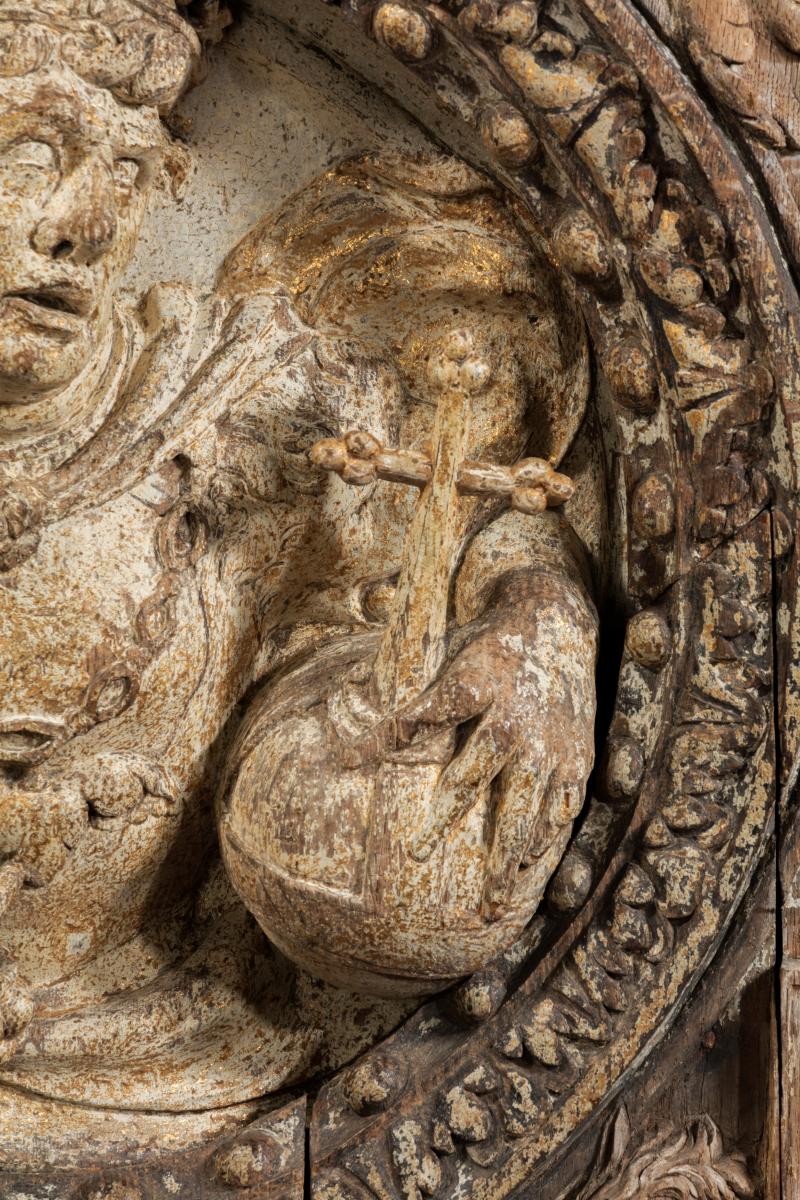
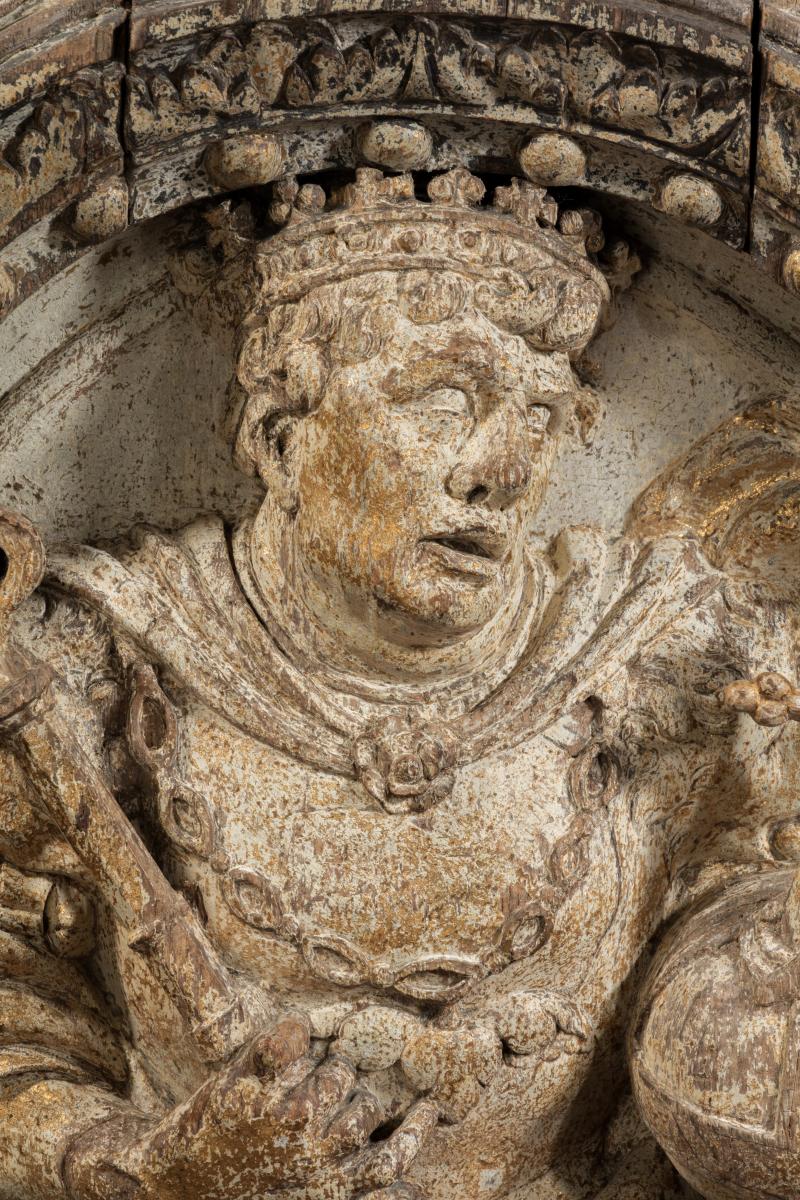
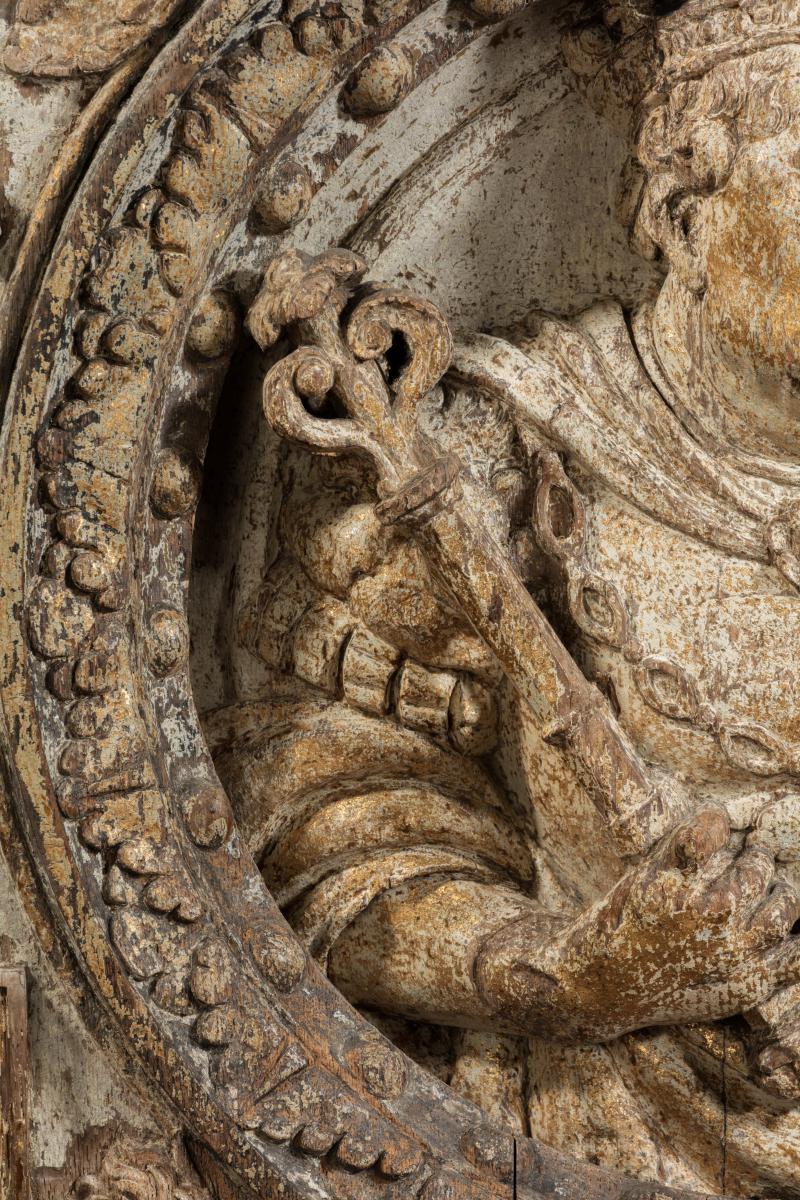
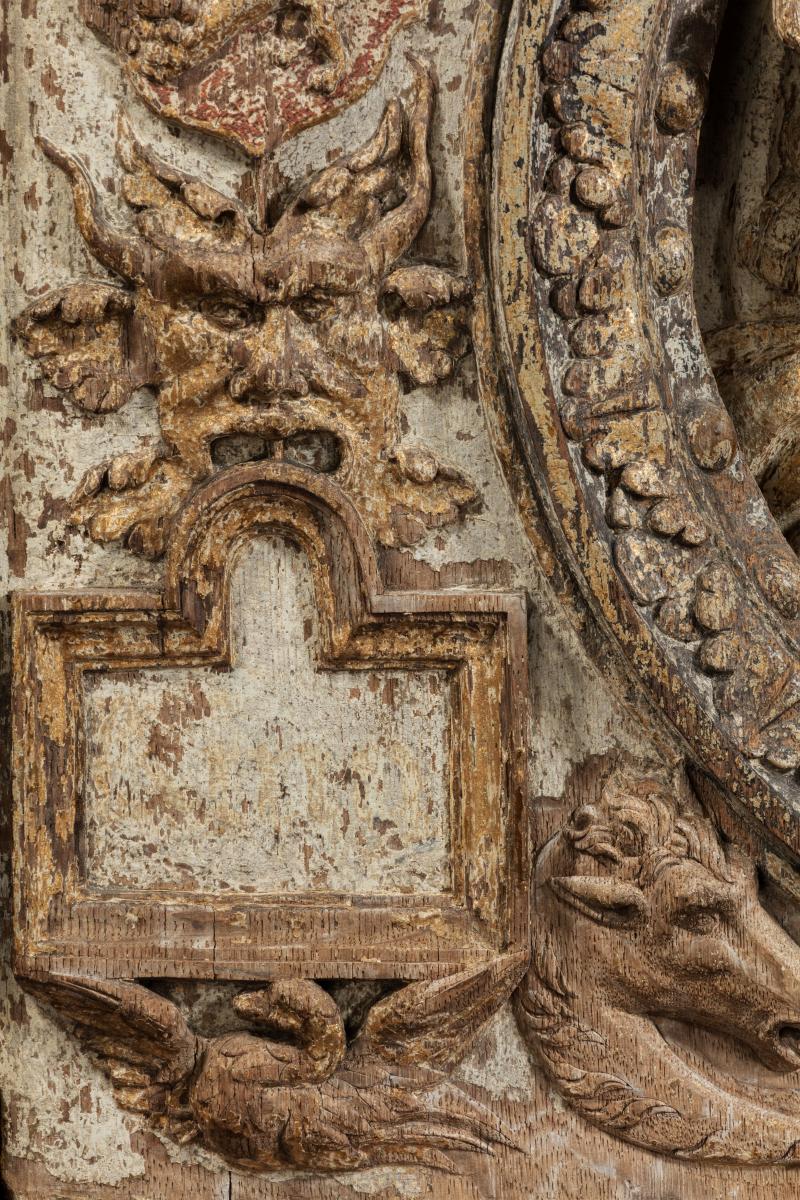
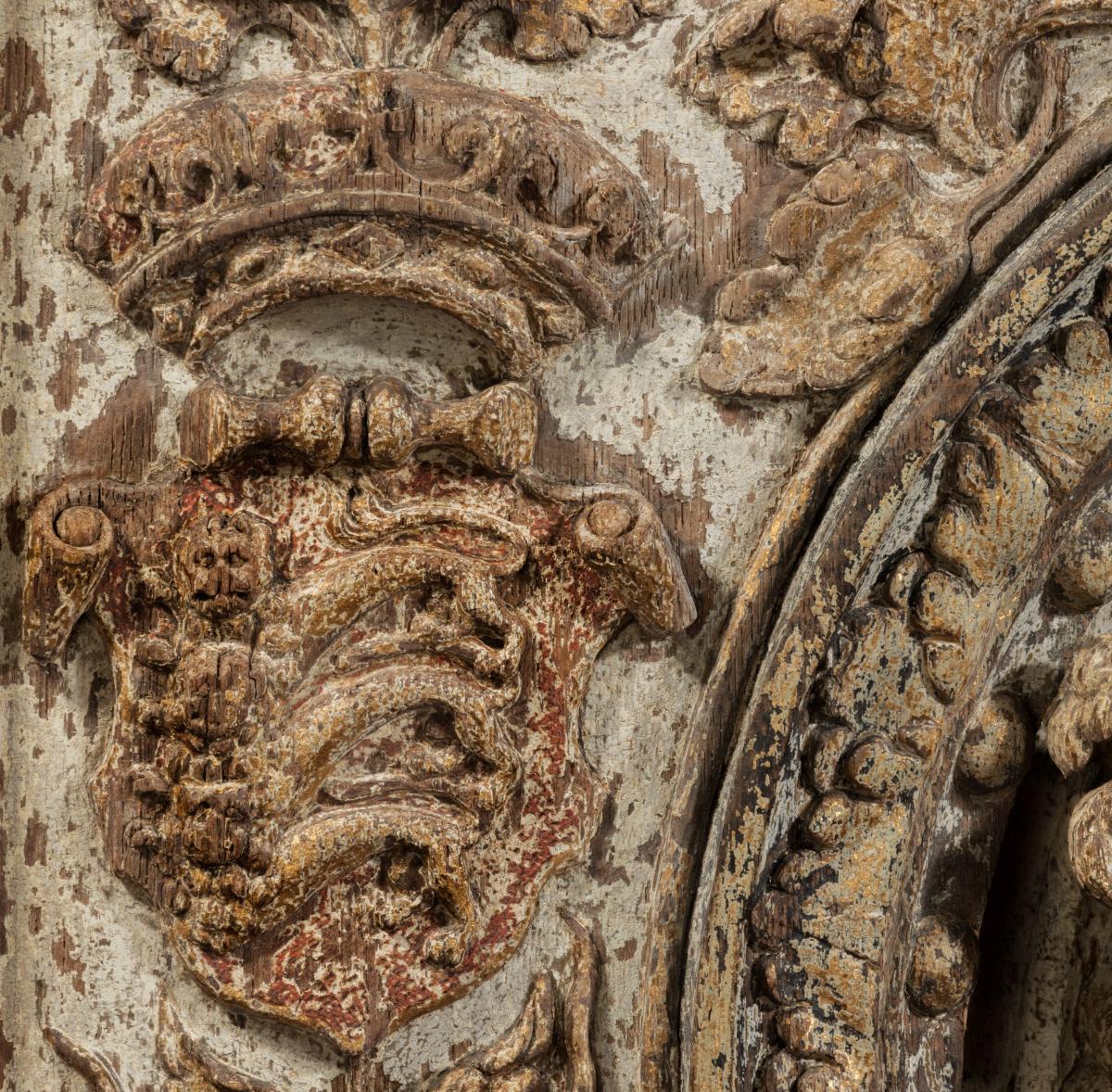
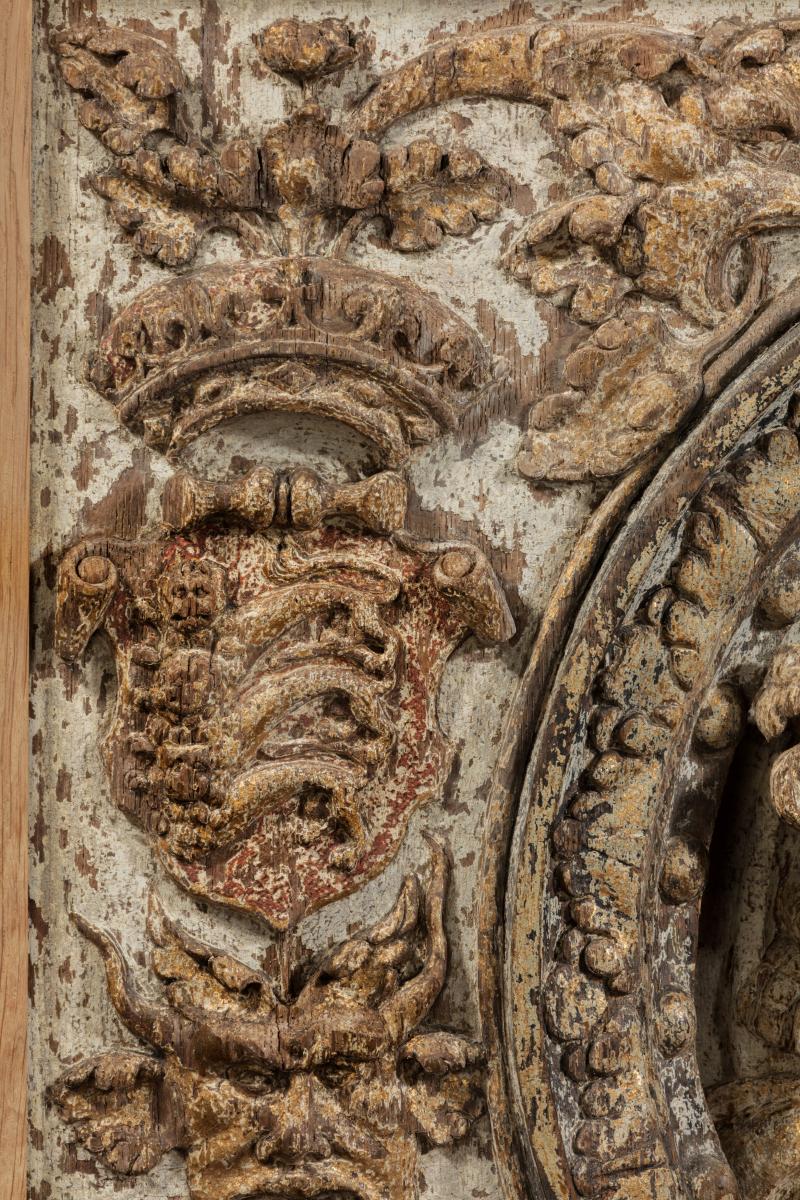
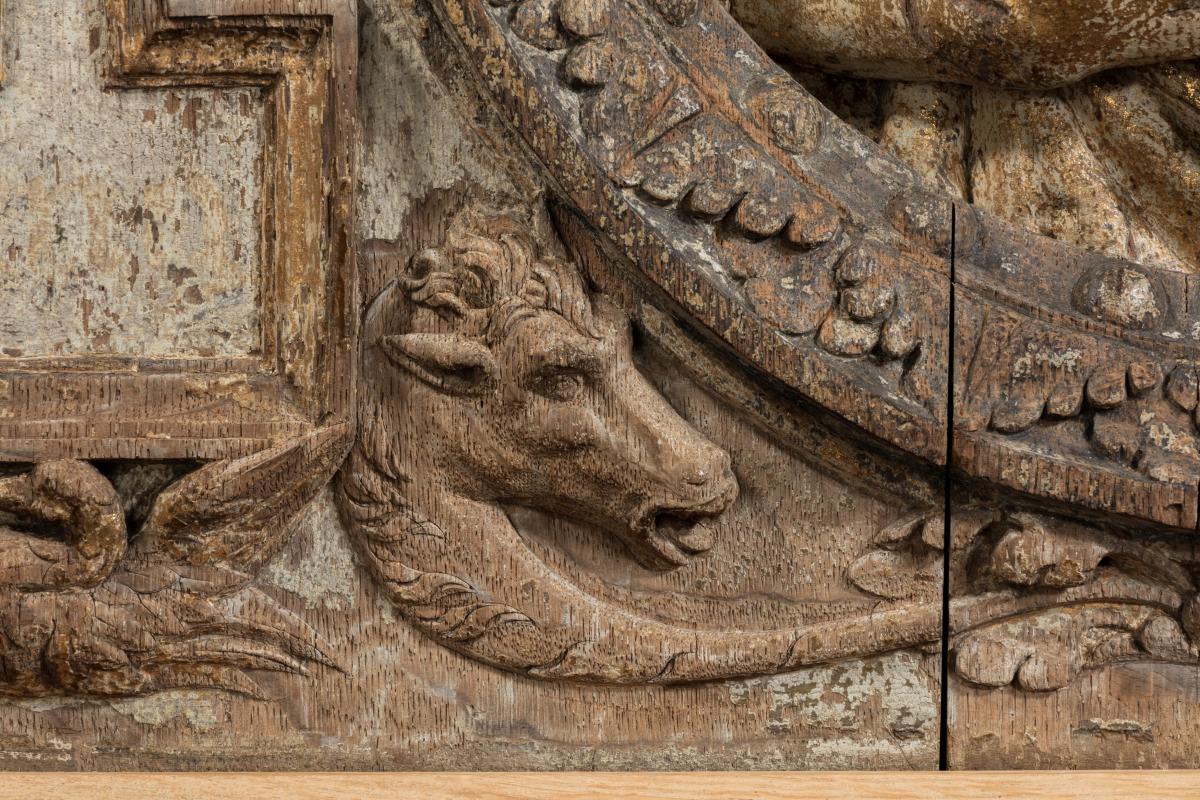
Price on application
This object includes complimentary, Insured Shipping / Delivery within the UK
This object is eligible for a Certificate of BADA Provenance
The BADA Standard
- Since 1918, BADA has been the leading association for the antiques and fine art trade
- Members are elected for their knowledge, integrity and quality of stock
- Our clients are protected by BADA’s code of conduct
- Our dealers’ membership is reviewed and renewed annually
- Bada.org is a non-profit site: clients deal directly with members and they pay no hidden fees
Tudor Carved Oak Relief Panel of King John.
England, Circa 1530.
Provenance:
Probably commissioned circa 1530 by Lord De La Warr during his redecoration of the main Hall at Halnaker
1540 de la Warr was forced to relinquish Halnaker to King Henry VIII
Halnaker was granted by indenture to Sir John Jenyns, Esquier and Gentleman of Henry's Privy Chamber, the Master of the Ordinance in Boulogne, until his death in 1545
1561 the house was granted to Henry, 12th Earl of Arundel
1566 settled on Henry’s son-in-law John, Lord Lumley
1587 sold to Sir John Morley of Saxham, Suffolk
Thence by descent in the Morley family until Mary Morley, Dowager Countess Derby (who had married James, 10th Earl of Derby in 1704) died in 1752 and left the estate to Sir Thomas Dyke Acland
1765 Charles Lennox, 3rd Duke of Richmond bought Halnaker for £48,000
Dukes of Richmond, panel removed to Goodwood House by 1822, until 1939
Private Collection, UK
Literature:
D. Jacques, Librarian of Goodwood, A Visit to Goodwood, near Chichester, the seat of His Grace the Duke of Richmond with an Appendix, descriptive of an ancient painting. (William Mason, Chichester, 1822).
The Bognor, Arundel and Littlehampton Guide, Comprising a History of those Places, and of the Castle of Arundel; with topographical notices of the Villages of Aldwick, Pagham, Northmundham, Selsey, Felpham, Middleton, Yapton, Walberton, Slindon, Bartham, Boxgrove, &c. &c. with a Full Description of Good House and of the Roman Remains at Bignor (William Mason, Chichester, 1828, p. 150).
The 1903 Inventory of Goodwood House in the Long Hall: , 'an antique carved wood and gilt panel, 29 x 23 ins, with Coat of Arms and masks in relief & in the centre a representation of King John with the Orb & Sceptre'
Country Life Picture Library, photo no. 4726468 of the Long Hall at Goodwood, illustrated - situated above the door
Victoria & Albert Museum: Fifty Masterpieces of Woodwork (Her Majesty's Stationery Office, London, 1955), no. 18. An Oak Panel; mentions ‘a panel found at Goodwood House’
Victoria & Albert Museum: Collection Museum Number: 1585-1855; Online Object History
With remnants of original gilt and polychrome decoration.
History of Ownership:
The earliest reference to reveal the panel’s provenance from Halnaker House, was in 1822: In D. Jacques, A Visit to Goodwood near Chichester the seat of His Grace the Duke of Richmond (Chichester, 1822), p. 45, in a list of paintings and other works of art at Goodwood: ‘An ancient carving in wood, gilt and inscribed “King John,” brought from the old mansion at Halnaker.’ Later, in 1828, in Chapter X on Halnaker in The Bognor, Arundel and Littlehampton Guide, etc. (William Mason, Chichester, 1828, p. 150), it states: ‘At Goodwood is an ancient carving in wood, gilt, and inscribed “King John,” which was carried away from this mansion.’
During the 16th century, Lord De La Warr made various additions and alterations to Halnaker House. J. Lewis André comments: ‘The hall at Halnaker appears to have been a part of the house which received especial attention, and he [Lord De La Warr] panelled its walls from floor to ceiling with rich and elegant work… These panels, from descriptions left of them, must have been exceedingly intricate and beautiful’ (J. Lewis André, Halnaker House, Sussex Archaeological Collections, Volume 43, 1900, pp.201-213). The Historic England website also also references this: ‘The centrally placed entrance porch, which is of 14th century date, provided access to the main hall above it, which was elaborately decorated in the 16th century by Lord De La Warr, with intricately carved panels and other enrichments. After further modifications in the 18th century by the Duke of Richmond, the house was allowed to fall into decay during the early 1800s.’
S.H. Grimm painted watercolours of some of the panelling in the late 18th century, and whilst these paintings contain some panels of a similar shape, this panel is not evident. Between 1498 and 1540, the de la Warr’s had ownership of Halnaker, and Henry VIII and Edward VI both visited the estate whilst on progress. Interesting Halnaker was in fact owned by Henry VIII from 1540 until his death, but there is scant reference to visits he might have made there.
Related panels:
Two other panels of closely related compositions are known. One is in the collection of the Museum of London, and is a representation of King Stephen. It is thought to have possibly originally formed part of a decorative frieze in Winchester House, the London residence built in the 1500s by Lord Treasurer, Sir William Paulet, Marquis of Winchester, within the precincts of the dissolved friary. This panel was recoloured and gilded in 1912.
The second panel is in the collection of the Victoria & Albert Museum (Museum Number: 1585-1855). It was acquired by the Museum in 1855 and has been historically linked to the Paulet provenance on the basis of its evident relationship with the Museum of London panel, before the discovery of the “Goodwood” panel.
Technical Analysis:
Dendrochronological tests have recently been undertaken by Ian Tyers on the King John panel and the V&A panel. Copies of the full reports are available. The summary of the findings for this panel is as follows: ‘This oak panel was constructed from 3 vertical oak boards on the front, and 2 vertical oak boards on the back. Analysis of the tree-ring sequences from the back boards provides dates for both of these boards. These 2 boards were derived from 2 different trees sourced from the eastern Baltic area of Europe. One of the boards was identified as from the same tree as one used in a related panel [the panel at the V&A]. The combined tree-ring dating result suggests that both these panels date from c.1520-c.1552.’
Ian Tyers, Dendrochronological Consultancy Report 1176, November 2019
All three panels are the same size.
Conservation:
A thick layer of varnish had been applied to the surface of the panel at some point in 19th century. It was so thick that droplets had formed as the excess varnish dried while running down the face of the King. This varnish was carefully removed to reveal the remnants of much earlier decoration below.
Subject Matter:
The earliest reference to this panel was by D. Jacques in 1822 (op. cit. above) when it was described as being inscribed “King John”. Remnants of the inscription were visible before the removal of the varnish. While the inscription was not thought to be part of the original decorative scheme, its style and colouring and the fact that it was in English, all suggest it had been added, but the early 19th century reference to it being King John must have been for a reason and so should carry some weight. All three panels share several features which suggest that they were, in fact, intended as royal portraits. First, the regalia with which they are furnished is stylised, but bears a resemblance to that with which English kings were furnished in printed works which pre-dated this panel. John Rastell (1468-1536, Sir Thomas More's brother-in-law) published The Pastyme of People or The Cronycles of Englande and of Dyvers other realmys [STC 20724], in 1529/1530, a chronicle which included the novelty of single page woodcut illustrations of every King of England since the Conquest, rendering them with orbs, sceptres and swords very like those which appear on this series of panels. In addition, their crowns – coronet like, rather than arched or enclosed – bear alternating fleur-de-lis and either trefoils or crosses in their upper band, as do the crowns to the three busts in this, the V&A's and the Museum of London's panels. Giles Godet's A Brief Abstract of the Genealogie and Race of All the Kynges of England [1552 [STC 10022], which drew on Rastell, a Dutch work of 1534 (Alle De Coninghen, in Enghelant) also containing portraits of English kings, and another – lost – work which is known to have influenced all three, depicts Richard I with a clasp on his cloak very like the cherub clasp to the figure in the panel in the V&A. It is the heraldry, however, which most compellingly suggests that these panels represent English kings. The Museum of London panel, later painted with the title King Stephen, probably does represent him; the symbol given in the shields flanking his roundel is a single equine centaur or ‘sagittary’, which is known to have been one of the personal badges that King Stephen used. Rastell's The Pastyme of People shows Stephen standing beneath a shield charged with three ‘sagittarii’.Fifty Masterpieces of Woodwork (Victoria & Albert Museum, Her Majesty’s Stationery Office, London, 1955), no. 18 notes that the heraldry to these panels is explicitly English, in that the central bust is flanked by 'a crowned shield bearing three lions passant guardant, from the Royal Arms of Henry VIII'. The same shields flank the bust in the panel offered here. The three lions were first used by Richard I (or Lionheart) from c. 1198 and used by his successors until 1340. That is to say that they were used by King John (1199 – 1216), Henry III (1216 – 1272), Edward I (1272 – 1307), Edward II (1307 – 1327), and Edward III (1327 – 1377) until 1340. In Rastell's Pastyme, this convention is observed, with Stephen given three sagittarii, and his successors up until Edward II the three lions passant guardant. The concept of the Divine Right of Kings suited the political motives of Henry VIII and legitimate succession was essential to support this ideology. The series of mural portraits of English monarchs in roundels by Lambert Barnard at Chichester Cathedral serve to are reinforce the legitimate succession of the monarch, and it is possible that the scheme to which this panel belonged, was using images of past kings to reinforce the Tudors’ right to the throne.
The Design:
The influence of the Florentine Renaissance in Tudor England was considerable and Henry VIII’s desire to make an impact amongst other European monarchs led to painters and sculptors from Italy and France being commissioned to create new interiors for Royal Palaces to impress – and compete with – visiting diplomats and foreign royalty. The concept of this panel, centred by a circular framed “Roman” medallion and deep relief carved portrait within echoes other examples of Renaissance art created in early Tudor England. Notably the portrait heads by Torrigiano at Westminster Abbey and the Wallace Collection, the terracotta roundel of Emperor Probus at The Vyne and roundel heads by Giovanni da Maiano at Hampton Court. Cardinal Wolseley commissioned Benedetto de Rovezzano to design and produce his tomb. It was later adopted by Henry VIII and ultimately broken up but Rovezzano’s columns for the tomb still exist and are currently found in Ghent. The decorative motifs employed on the columns relate very closely to many of those on the present panel showing the strong influence of Florentine technique and design. A chimney-piece design by Hans Holbein the Younger (1497/8–1543) preserved in the British Museum (Museum no. 1854,0708.1), featuring roundels and similar grotesque foliate ornament typical of early Renaissance woodwork in this country, resonates with the carving of these three panels. The British Museum catalogue German Drawings in the British Museum... by artists born before 1530 (1993) 2 vols., No. 327, notes 'on stylistic grounds, the drawing may preferably be placed towards the end of Holbein's career, c. 1537 - 43. The design of this chimney-piece is reflected in English architecture of later decades, such as the grand chimney-piece, at Loseley, near Guildford, Surrey, of 1562-8…’Hans Holbein was in England between 1526 and 1528 and returned for a second visit in 1531/2–1543. His dates, therefore, overlap with these panels, and it is possible that he designed them. They certainly share features with his other known designs. Compare, for instance, the foliated scrolls and grotesque terminals to these panels, and those to a 1543 design of Holbein's of an elaborate clock salt for Sir Anthony Denny [British Museum Number 1850,0713.14].Other commentators have drawn comparisons between the V & A panel (in the same series as the panel offered here) and work which may have derived, in part, from Holbein's designs. Thus, the catalogue of the 'woodwork' in the V & A, published in 1874 noted that 'the character of the workmanship, as well as that of the design, so closely resemble those of the ornamental work on the stalls of King's College, Cambridge, that we may attribute them to the same period and the same hand - that of an Italian or German Carver, in all probability, though executed in England' [Ancient & Modern Furniture & Woodwork in the South Kensington Museum (London, 1874), p. 209]. In 1908, the same association was made by John Hungerford Pollen who, in describing the V & A panel, noted that 'the workmanship as well as the design so closely resemble the character of the carved ornament on the stalls of King's College, Cambridge, that the panel may certainly be attributed to the same period' [English Objects (Ancient and Modern) (1908, Vol. 1, p. 83, Figure 64]. Elements of the design of the carving at King's, for instance the 'HISA' cipher, carved twice in stone in the choir stalls in King's College chapel, are also preserved in a drawing in the British Museum [Sloane bequest 17052 – 5303 – 3], attributed to Hans Holbein.
Conclusion:
This exceptional panel is a highly sophisticated example of the influence of the Florentine Renaissance in Tudor England. The discovery, thanks to the recent dendrochronological analysis, that this ‘King John’ panel and the companion panel in the Victoria and Albert Museum both incorporate an oak board cut from the same tree, confirm what is already suggested by their evidently similar design; that they were surely intended for the same decorative scheme. Given that there is documentary evidence that panel was at Halnaker House in the 18th Century, and that Lord de la Warr installed impressive carved oak panelling there in the first half of 16th Century before the house was purchased in 1540 by King Henry VIII, it is reasonable to suggest that these panels may well have been originally installed there.
We are extremely grateful to Megan Wheeler for her extensive research and contribution to these notes; to Nick Humphries and his colleagues in the Department of Furniture and Woodwork at the Victoria and Albert Museum for allowing access to make close comparison of the construction of the King John panel and theirs, and allowing Ian Tyers to access to analyse the V&A panel to facilitate dendrochronological comparison of the two panels.
Dimensions
47 x 59.4 x 7 cmPrice on application
This object includes complimentary, Insured Shipping / Delivery within the UK
This object is eligible for a Certificate of BADA Provenance
Stock number
6368The BADA Standard
- Since 1918, BADA has been the leading association for the antiques and fine art trade
- Members are elected for their knowledge, integrity and quality of stock
- Our clients are protected by BADA’s code of conduct
- Our dealers’ membership is reviewed and renewed annually
- Bada.org is a non-profit site: clients deal directly with members and they pay no hidden fees


